Welcome to beautiful Goa, where your adventure to becoming a certified 200 hours yoga teacher training in goa program is carefully designed to help you understand yoga philosophy, how the body works, how to teach, and how to improve your own yoga skills. Imagine learning all of this surrounded by stunning views and peaceful settings. It’s like practicing yoga in paradise!
The 200 hours yoga teacher training in Goa is a thorough program that helps people become certified yoga instructors. It’s held in the beautiful surroundings of Goa, offering a diverse curriculum covering yoga philosophy, anatomy, teaching methods, and more.So, if you’ve ever dreamed of becoming a yoga teacher or simply want to enhance your knowledge and skills, this program is perfect for you. Get ready to embark on a journey of self-discovery and growth while enjoying the natural beauty of Goa.
Your yoga adventure awaits!
200 hours Yoga Teacher Training in Goa: An Overview
Join 200 hours Yoga Teacher Training in Goa for an immersive experience in yoga philosophy, anatomy, teaching methodology, and more. Dive into the origins and evolution of yoga, exploring ancient texts like the Yoga Sutras and Bhagavad Gita. Understand how yoga affects the skeletal, muscular, and nervous systems to prevent injuries. Learn teaching principles and gain practical experience through supervised teaching practice. Complete written and practical exams to earn your certification, celebrating your achievement at our graduation ceremony.
Curriculum for 200 Hours Yoga Training In Goa
Yoga Philosophy
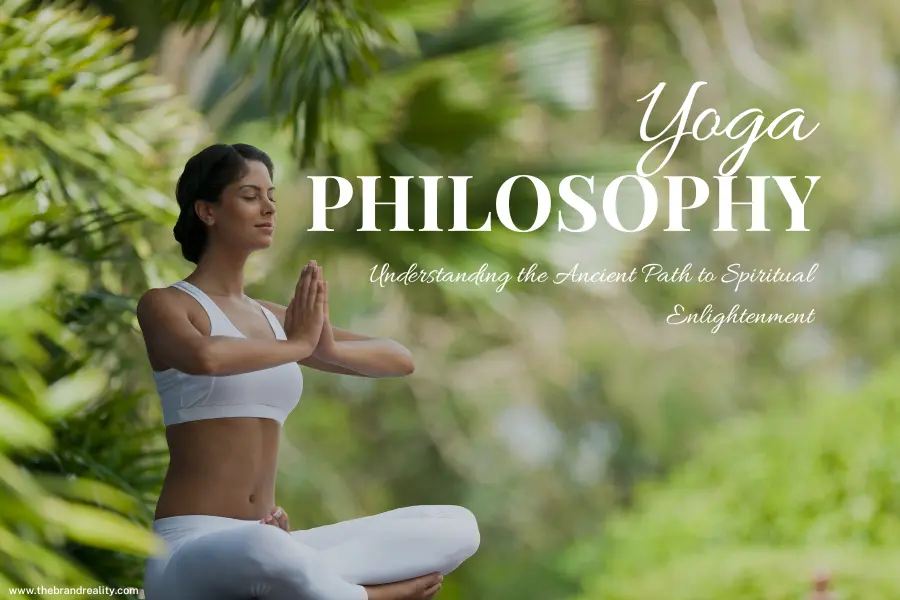
- Introduction to the History and Philosophy of Yoga:
- Understand the origins and evolution of yoga, tracing its roots from ancient civilizations to modern-day practices.
- Explore the diverse philosophical schools that have contributed to the development of yoga, including Vedanta, Samkhya, and Tantra.
- Gain insight into the cultural, social, and spiritual contexts that shaped the philosophy of yoga over thousands of years.
- Study of Ancient Texts such as Yoga Sutras, Bhagavad Gita, and Hatha Yoga Pradipika:
- Dive into the rich wisdom contained in classical yoga texts, such as the Yoga Sutras of Patanjali, the Bhagavad Gita, and the Hatha Yoga Pradipika.
- Analyze key concepts, teachings, and practices outlined in these texts, including the paths of yoga, ethical guidelines, and techniques for spiritual growth.
- Examine the relevance of these ancient texts in modern yoga practice and their enduring impact on contemporary yogic philosophy.
- Exploration of Key Concepts including the Eight Limbs of Yoga, Karma, Dharma, and Self-Realization:
- Delve into the foundational principles of yoga philosophy, including the Eight Limbs of Yoga as outlined by Patanjali in the Yoga Sutras.
- Study the concept of karma (action) and its role in shaping individual destinies, as well as the ethical principles of dharma (duty/righteousness) in guiding one’s actions.
- Reflect on the ultimate goal of yoga: self-realization (moksha or liberation), and explore different paths and practices aimed at attaining spiritual enlightenment.
Anatomy and Physiology
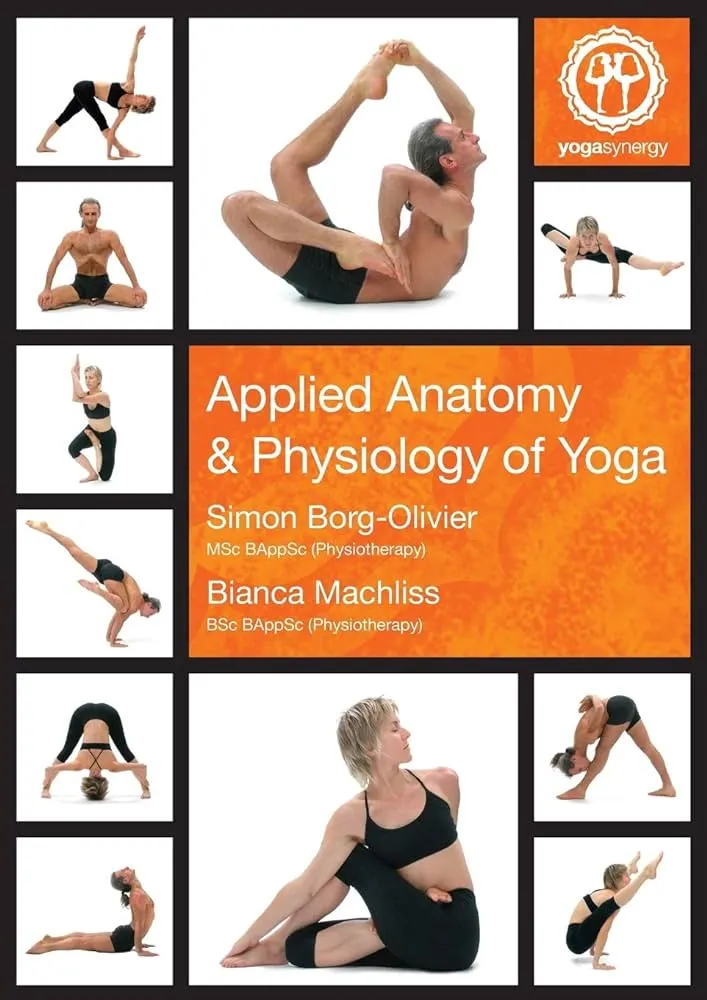
- Understanding the Skeletal, Muscular, and Nervous Systems in Relation to Yoga Practice:
- Explore the structure and function of the skeletal system, including bones and joints, to understand how yoga poses affect different parts of the body.
- Study the muscular system, learning about different muscle groups and their role in movement, stability, and flexibility during yoga practice.
- Gain insight into the nervous system and its involvement in coordinating movement, balance, and proprioception (awareness of body position) during asana practice.
- Examination of Common Yoga-Related Injuries and How to Prevent Them:
- Identify common yoga-related injuries such as strains, sprains, and overuse injuries, understanding their causes and risk factors.
- Learn preventive measures to minimize the risk of injuries during yoga practice, including proper warm-up, alignment cues, and modifications for individual limitations.
- Explore strategies for creating a safe and supportive practice environment, including using props, providing clear instructions, and offering variations for different body types and abilities.
- Application of Anatomical Knowledge to Alignment and Adjustments in Asanas:
- Apply anatomical principles to understand optimal alignment in yoga poses, ensuring safe and effective practice.
- Learn techniques for observing and assessing alignment in students, recognizing common misalignments and their potential impact on the body.
- Develop skills in providing hands-on adjustments and verbal cues to help students achieve proper alignment, deepen their practice, and prevent injuries.
Asana Practice
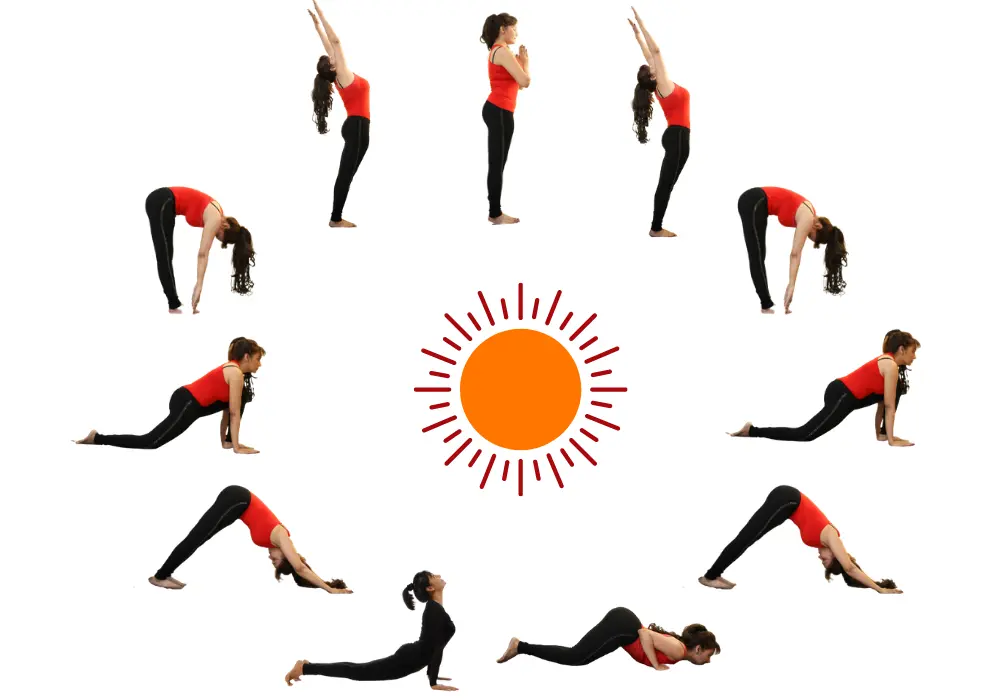
- Daily Practice of Foundational Yoga Asanas with Focus on Alignment, Breath, and Mindfulness:
- Engage in daily sessions dedicated to practicing foundational yoga asanas, including basic standing, seated, balancing, and supine poses.
- Emphasize the importance of proper alignment to ensure safety and effectiveness in each pose, understanding how alignment impacts the body’s alignment and energy flow.
- Integrate breath awareness (pranayama) into the practice, coordinating breath with movement to cultivate a sense of flow and presence in each pose.
- Cultivate mindfulness throughout the practice, encouraging students to stay present and aware of sensations, thoughts, and emotions as they move through the asanas.
- Exploration of Advanced Asanas and Variations to Deepen the Practice:
- Progressively explore more advanced yoga asanas and variations, building upon the foundation established in foundational poses.
- Offer modifications and adaptations to accommodate different levels of practice and individual abilities, ensuring accessibility and inclusivity in the practice.
- Guide students in safely exploring their edge and expanding their practice, encouraging them to challenge themselves while honoring their bodies’ limitations and boundaries.
- Foster a spirit of curiosity and exploration, inviting students to approach advanced asanas with an open mind and a willingness to learn and grow.
- Sequencing and Structuring of Asana Classes for Different Levels and Themes:
- Learn the art of sequencing and structuring yoga classes, understanding how to create balanced and cohesive class experiences that address different levels and themes.
- Explore various class formats, including vinyasa flow, hatha, yin, and restorative yoga, adapting sequencing and pacing to suit the intended focus and energy level of the class.
- Incorporate themes and intentions into class sequences, weaving together asanas, pranayama, meditation, and philosophical teachings to create a holistic and meaningful practice experience.
- Understand the importance of offering progressive sequences that prepare the body for more challenging poses, ensuring a safe and effective progression throughout the class.Understand how variations and modifications can be used to accommodate individual anatomical differences and support students in finding their unique expression of each pose.
Teaching Methodology
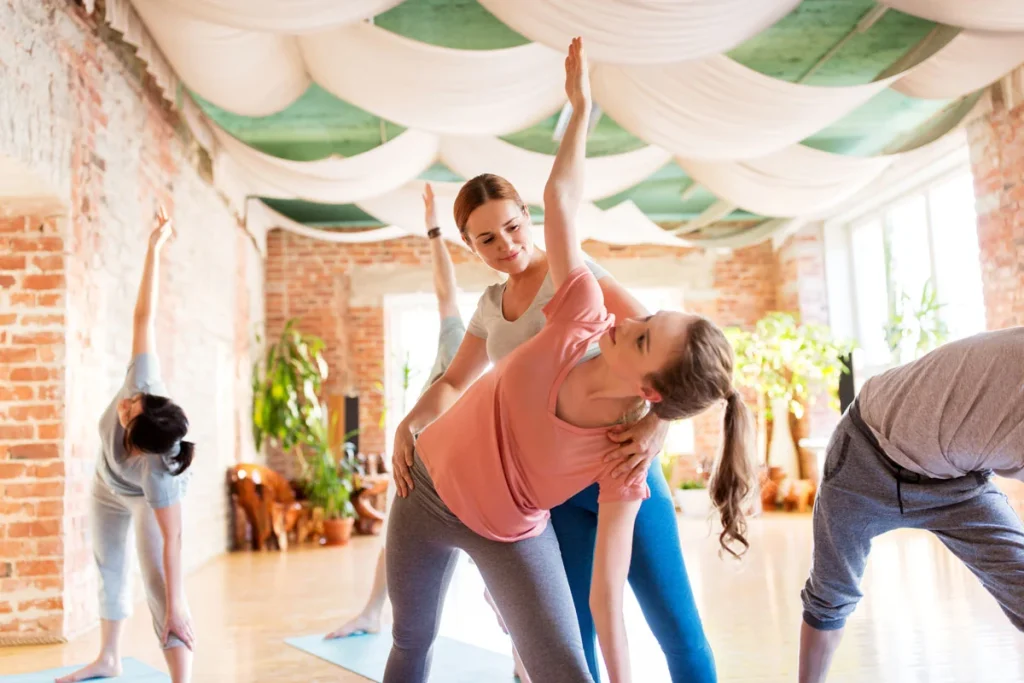
- Principles of Effective Teaching including Communication, Demonstration, and Observation:
- Understand the fundamental principles of effective teaching, including clear communication, engaging demonstration, and attentive observation.
- Learn how to communicate instructions and cues clearly and succinctly, using language that is accessible and inclusive to all students.
- Develop skills in demonstrating yoga poses with precision and clarity, highlighting key alignment cues and variations to accommodate different levels of practice.
- Cultivate the ability to observe students’ alignment, engagement, and energy levels during practice, using observation as a tool for providing individualized guidance and support.
- Practice Teaching Sessions with Feedback and Guidance from Instructors and Peers:
- Engage in regular practice teaching sessions where you have the opportunity to lead yoga classes under the guidance of experienced instructors and with the support of your peers.
- Receive constructive feedback and guidance from instructors and peers on your teaching style, communication skills, and ability to create a supportive and inclusive class environment.
- Utilize feedback to reflect on and refine your teaching approach, integrating suggestions for improvement and building confidence in your teaching abilities.
- Participate in peer-to-peer feedback sessions, offering supportive and constructive feedback to fellow trainees, enhancing your ability to give and receive feedback effectively.
- Development of Lesson Plans and Class Sequences Tailored to Specific Student Needs:
- Learn how to create comprehensive and well-structured lesson plans and class sequences that cater to the specific needs and goals of your students.
- Understand the importance of considering factors such as students’ experience levels, physical abilities, and preferences when designing class sequences.
- Explore different approaches to sequencing, including thematic sequencing, peak pose sequencing, and class pacing, to create varied and engaging class experiences.
Develop the ability to modify and adapt class sequences on the spot based on student feedback, energy levels, and any specific needs or concerns that arise during the class.
Meditation and Pranayama
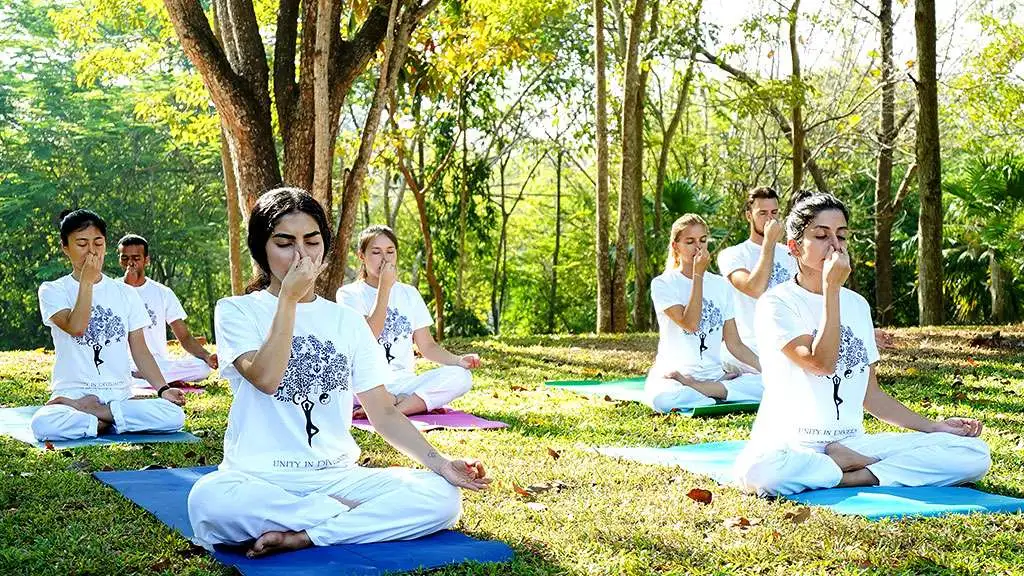
- Introduction to Various Meditation Techniques for Cultivating Focus and Awareness:
- Explore a variety of meditation techniques aimed at cultivating focus, concentration, and inner awareness.
- Learn mindfulness meditation practices, such as breath awareness meditation, body scan meditation, and loving-kindness meditation.
- Understand the principles and benefits of each meditation technique, including their effects on the mind, emotions, and overall well-being.
- Practice techniques for quieting the mind, observing thoughts without attachment, and cultivating a sense of presence and inner stillness.
- Practice of Different Pranayama (Breathing) Techniques to Regulate Energy and Calm the Mind:
- Dive into the practice of pranayama, or yogic breathing techniques, aimed at regulating the flow of prana (life force energy) in the body.
- Explore various pranayama techniques, including deep belly breathing (diaphragmatic breathing), alternate nostril breathing (Nadi Shodhana), and Kapalabhati (skull shining breath).
- Understand the physiological and psychological effects of each pranayama technique, including their ability to calm the mind, increase energy levels, and balance the nervous system.
- Practice pranayama techniques with focused attention on breath awareness, rhythm, and control, gradually deepening your breath and refining your technique.
- Integration of Meditation and Pranayama into Personal Practice and Teaching:
- Explore ways to integrate meditation and pranayama practices into your personal yoga practice, creating a holistic and balanced approach to your daily routine.
- Understand how meditation and pranayama complement asana practice, serving as tools for deepening self-awareness, managing stress, and cultivating inner peace.
- Learn how to incorporate meditation and pranayama techniques into your yoga classes as a teacher, offering students opportunities for introspection, relaxation, and mindfulness.
Ethics and Professionalism
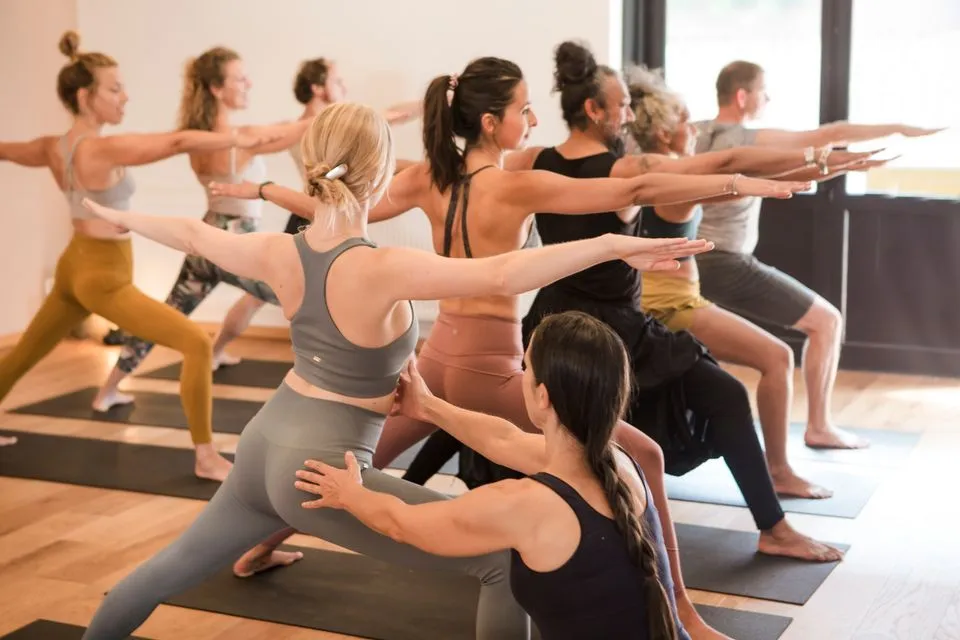
- Understanding Ethical Guidelines for Yoga Teachers:
- Explore the ethical principles that guide the practice and teaching of yoga, including honesty, integrity, compassion, and non-harming (ahimsa).
- Discuss the ethical considerations involved in teaching yoga, such as respecting student boundaries, maintaining confidentiality, and upholding professional standards of conduct.
- Responsibilities in the Teacher-Student Relationship:
- Understand the responsibilities of yoga teachers in establishing and maintaining a safe and supportive environment for students to practice yoga.
- Explore the importance of clear communication, boundaries, and consent in the teacher-student relationship, ensuring a respectful and empowering learning environment.
- Professional Conduct and Boundaries:
- Learn about professional conduct guidelines for yoga teachers, including appropriate attire, language, and behavior during classes and interactions with students.
- Discuss the importance of maintaining professional boundaries with students, including avoiding dual relationships and maintaining confidentiality.
- Continued Personal Practice and Professional Development:
- Emphasize the importance of continued personal practice as a yoga teacher, recognizing the role of self-care and self-awareness in maintaining a balanced and sustainable teaching practice.
- Explore opportunities for ongoing professional development, including attending workshops, continuing education courses, and engaging in mentorship or supervision with experienced teachers.
- Discuss strategies for self-reflection and evaluation as a yoga teacher, identifying areas for growth and improvement in teaching skills, communication, and knowledge of yoga philosophy and practice.
- Cultural Sensitivity and Inclusivity:
- Understand the importance of cultural sensitivity and inclusivity in yoga teaching, recognizing and respecting the diversity of backgrounds, experiences, and identities among students.
- Discuss strategies for creating inclusive and welcoming yoga spaces that honor and celebrate the diversity of yoga practitioners, regardless of race, ethnicity, gender, sexual orientation, or ability.
- Ethical Considerations in Business and Marketing:
- Explore ethical considerations in business practices and marketing for yoga teachers, including transparency, honesty, and integrity in advertising, pricing, and promotion of services.
- Discuss the importance of offering fair and accessible pricing options for yoga classes and services, ensuring that yoga remains accessible to all individuals regardless of financial means.
Practicum and Teaching Experience
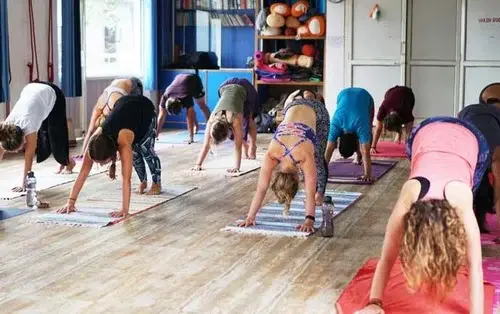
- Supervised Teaching Practice:
- Engage in supervised teaching practice sessions where you have the opportunity to lead yoga classes under the guidance and supervision of experienced instructors.
- Apply the knowledge and skills acquired during the training program to plan and teach yoga classes to your peers and fellow trainees.
- Receive constructive feedback and guidance from instructors and peers on your teaching style, communication skills, class sequencing, and ability to create a supportive and inclusive class environment.
- Assisting Lead Instructors:
- Assist lead instructors in regular yoga classes, workshops, or events, gaining hands-on experience in assisting and supporting students during their practice.
- Learn how to observe students’ alignment and offer appropriate adjustments and modifications to ensure safe and effective practice.
- Gain insights into class management, pacing, and the dynamics of leading a yoga class from an experienced instructor’s perspective.
- Teaching Practicums:
- Participate in teaching practicums where you independently lead yoga classes for your peers and fellow trainees.
- Develop lesson plans and class sequences tailored to specific themes, levels, or student needs, incorporating elements of asana practice, pranayama, meditation, and philosophy.
- Receive feedback and constructive criticism from instructors and peers on your teaching effectiveness, class sequencing, pacing, and ability to create a cohesive and engaging class experience.
- Integration of Feedback:
- Reflect on feedback received from instructors and peers during teaching practice sessions and practicums.
- Identify areas for improvement in your teaching skills, communication, and class management, and develop strategies for addressing these areas in future teaching sessions.
- Incorporate constructive feedback into your teaching approach, refining your teaching style, sequencing, and communication skills to enhance the overall quality of your yoga classes.
- Gradual Progression and Growth:
- Gradually progress from observing and assisting in yoga classes to leading and teaching classes independently as you gain confidence and experience.
Embrace challenges and opportunities for growth as you navigate the transition from student to teacher, continually refining your teaching skills, deepening your understanding of yoga, and honing your ability to create meaningful and impactful yoga experiences for your students.
Final Assessment and Certification
- Evaluation of Practical Teaching Skills, Knowledge, and Understanding of Yoga Principles:
- Your practical teaching skills, knowledge, and understanding of yoga principles will be evaluated through a combination of observation, feedback, and assessment by experienced instructors.
- This evaluation encompasses your ability to effectively lead yoga classes, demonstrate proper alignment and adjustments, communicate instructions clearly, and create a supportive and inclusive class environment.
- In addition to teaching skills, your understanding of key yoga principles, including philosophy, anatomy, teaching methodology, meditation, and pranayama, will also be assessed to ensure a comprehensive understanding of yoga.
- Successful Completion of Written and Practical Exams to Earn 200 Hours Yoga Teacher Training Certification:
- You will be required to complete both written and practical exams to demonstrate your proficiency and competence in various aspects of yoga teaching and practice.
- Written exams may include multiple-choice questions, short-answer questions, essays, or other formats to assess your theoretical knowledge of yoga philosophy, anatomy, teaching methodology, and related topics.
- Practical exams may involve teaching demonstrations, class sequencing, hands-on adjustments, and other practical assessments to evaluate your ability to apply yoga principles and techniques in a teaching setting.
- Successful completion of these exams, along with fulfilling all other requirements of the training program, will qualify you to receive a 200 hours yoga teacher training certification from the accredited institution or organization conducting the training.
- Graduation Ceremony and Celebration of Achievement:
- Upon successful completion of the training program and attainment of your 200 hours yoga teacher training certification, you will participate in a graduation ceremony to celebrate your achievement.
- The graduation ceremony serves as a formal acknowledgment of your dedication, commitment, and hard work throughout the training program.
- It is an opportunity to celebrate your growth, development, and transformation as a yoga practitioner and teacher, surrounded by your peers, instructors, friends, and family members who have supported you on your journey.
- The graduation ceremony typically includes speeches, presentations of certificates, awards, or special recognitions, and may also include rituals, performances, or other celebratory activities to mark this significant milestone in your yoga journey
Why Choose 200 Hours Yoga Teacher Training In Goa
- Serene and Picturesque Environment: Goa offers a beautiful setting with its serene beaches, lush greenery, and tranquil atmosphere, providing the perfect backdrop for an immersive yoga experience.
- Comprehensive Curriculum: The 200 hours yoga course in Goa covers a wide range of topics including yoga philosophy, anatomy, teaching methodology, meditation, and pranayama, ensuring a thorough understanding of yoga principles and practices.
- Experienced Instructors: The course is led by experienced instructors who provide expert guidance and support throughout the training, helping participants develop their skills and confidence as yoga teachers.
- Focus on Alignment and Mindfulness: Participants engage in daily yoga practice sessions with a focus on alignment, breath, and mindfulness, enhancing their personal practice and teaching abilities.
- Opportunities for Teaching Practice: The course includes supervised teaching practice sessions where participants have the opportunity to lead yoga classes and receive feedback from instructors and peers, gaining valuable hands-on experience.
Who Can Apply 200 hour Yoga Teacher Training Course In Goa
- Yoga Enthusiasts: Individuals who have a passion for yoga and want to deepen their practice and understanding of yoga principles and philosophy.
- Beginners: Those who are new to yoga but have a strong interest in learning and exploring the practice are welcome to apply.
- Experienced Practitioners: Experienced yoga practitioners looking to enhance their skills, refine their teaching techniques, and earn a recognized certification to teach yoga professionally.
- Fitness Instructors or Teachers: Fitness instructors or personal trainers or existing yoga teachers interested in integrating yoga into their existing fitness programs or expanding their knowledge and expertise in yoga.
- Travelers and Explorers: Travelers visiting Goa who are interested in immersing themselves in yoga practice and culture while exploring the vibrant surroundings of Goa.
- Anyone Seeking Personal Growth: Individuals seeking personal growth, self-discovery, and a transformative experience through the practice of yoga in a supportive and nurturing environment.
Top Ranked Schools for 200 hour Yoga Teacher Training In Goa
- Kranti Yoga Academy
- Sampoorna Yoga
- Ashiyana Yoga
- Yoga Magic
- Purple Valley Yoga Retreat
- Trimurti Yoga
- Abhinam Yoga Center
- AYM Yoga School
- Yoga Pranayama Mandala
- Krishna Yoga Shala
Check Out – Top Ranked Schools for Yoga Teacher Training in Goa India & 300 Hour Yoga Teacher Training in Goa
Conclusion:-







